6.6 Inverse Functions
An Alaskan business executive is heading to Calgary, Alberta in Canada for a conference. They ask their assistant, Niketa, what 75 degrees Fahrenheit is in Celsius and after a quick search on Google, she finds the formula ![]() . Using this formula, she calculates
. Using this formula, she calculates ![]() Celsius. The next day, the executive sends Niketa the week’s weather forecast for Calgary:
Celsius. The next day, the executive sends Niketa the week’s weather forecast for Calgary:
 At first, Niketa might consider the formula she has already found to do the conversions. After all, she knows her algebra and can easily solve the equation for
At first, Niketa might consider the formula she has already found to do the conversions. After all, she knows her algebra and can easily solve the equation for ![]() after substituting a value for
after substituting a value for ![]() . For example, to convert 25
. For example, to convert 25![]() C, she could write:
C, she could write:

After considering this option for a moment, she realizes that solving the equation for each of the temperatures would get awfully tedious, and realizes that since evaluation is easier than solving, it would be much more convenient to have a different formula, one which takes the Celsius temperature and outputs the Fahrenheit temperature. This is the idea of an inverse function, where the input becomes the output and the output becomes the input.
Inverse Function
If ![]() , then a function
, then a function ![]() is an inverse of
is an inverse of ![]() if
if ![]() for all values, a, in the domain and all values, b, in the range of
for all values, a, in the domain and all values, b, in the range of ![]() .
.
The inverse of ![]() is typically notated
is typically notated ![]() , which is read “f inverse of x”, so equivalently, if
, which is read “f inverse of x”, so equivalently, if ![]() then
then ![]()
 Important: The raised -1 used in the notation for inverse function is simply a notation, and does NOT designate an exponent or power of -1.
Important: The raised -1 used in the notation for inverse function is simply a notation, and does NOT designate an exponent or power of -1. ![]()
Example of Inverse Functions
If, for a particular function, ![]() , what do we know about the inverse?
, what do we know about the inverse?
The inverse function reverses which quantity is input and which quantity is output, so if ![]() , then
, then ![]() .
.
Alternatively, if you want to re-name the inverse function g(x), then g(4) = 2.
Try it Now 1
Given that ![]() , what do we know about the original function h(x)?
, what do we know about the original function h(x)?
Notice that original function and the inverse function undo each other. If ![]() , then
, then ![]() , returning us to the original input. More simply put, if you compose these functions together you get the original input as your answer.
, returning us to the original input. More simply put, if you compose these functions together you get the original input as your answer.
![]()
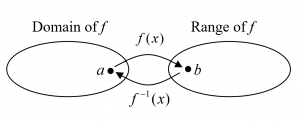
Since the outputs of the function ![]() are the inputs to
are the inputs to ![]() , the range of
, the range of ![]() is also the domain of
is also the domain of ![]() . Likewise, since the inputs to
. Likewise, since the inputs to ![]() are the outputs of
are the outputs of ![]() , the domain of
, the domain of ![]() is the range of
is the range of ![]() .
.
Basically, like how the input and output values switch, the domain & ranges switch as well. But be careful, because sometimes a function doesn’t even have an inverse function, or only has an inverse on a limited domain. For example, the inverse of ![]() is
is ![]() , since a square “undoes” a square root, but it is only the inverse of
, since a square “undoes” a square root, but it is only the inverse of ![]() on the domain
on the domain ![]() , since that is the range of
, since that is the range of ![]() .
.
Example of the Domain and Range of Inverses
The function ![]() has domain
has domain ![]() and range
and range ![]() , what would we expect the domain and range of
, what would we expect the domain and range of ![]() to be?
to be?
We would expect ![]() to swap the domain and range of
to swap the domain and range of ![]() , so
, so ![]() would have domain
would have domain ![]() and range
and range ![]() .
.
Example of Inverse Functions with a Function Defined by a Table
A function f(t) is given as a table below, showing distance in miles that a car has traveled in t minutes. Find and interpret ![]() .
.
| t (minutes) | 30 | 50 | 70 | 90 |
| f(t) (miles) | 20 | 40 | 60 | 70 |
The inverse function takes an output of f and returns an input for f. So in the expression ![]() , the 70 is an output value of the original function, representing 70 miles. The inverse will return the corresponding input of the original function f, 90 minutes, so
, the 70 is an output value of the original function, representing 70 miles. The inverse will return the corresponding input of the original function f, 90 minutes, so ![]() . Interpreting this, it means that to drive 70 miles, it took 90 minutes.
. Interpreting this, it means that to drive 70 miles, it took 90 minutes.
Alternatively, recall the definition of the inverse was that if ![]() then
then ![]() . By this definition, if you are given
. By this definition, if you are given ![]() then you are looking for a value a so that
then you are looking for a value a so that ![]() . In this case, we are looking for a t so that
. In this case, we are looking for a t so that ![]() , which is when t = 90.
, which is when t = 90.
Try it Now 2
Using the table below
| t (minutes) | 30 | 50 | 70 | 90 |
| f(t) (miles) | 20 | 40 | 60 | 70 |
Find and interpret the following:
a. ![]()
b. ![]()
Example of an Inverse with a Function Defined as a Graph
A function ![]() is given as a graph below. Find
is given as a graph below. Find ![]() and
and ![]()
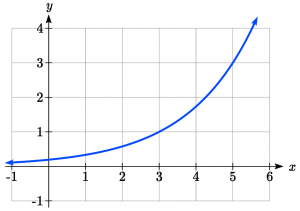
To evaluate ![]() , we find 3 on the horizontal axis and find the corresponding output value on the vertical axis. The point (3, 1) tells us that
, we find 3 on the horizontal axis and find the corresponding output value on the vertical axis. The point (3, 1) tells us that ![]() .
.
To evaluate ![]() , recall that by definition means
, recall that by definition means ![]() . By looking for the output value 3 on the vertical axis we find the point (5, 3) on the graph, which means
. By looking for the output value 3 on the vertical axis we find the point (5, 3) on the graph, which means ![]() , so by definition
, so by definition ![]() .
.
Try it Now 3
Using the graph in the example above
a. find ![]()
b. estimate ![]()
Example – Back to the Celsuis and Fahrenheit Temperature Problem
Returning to our executive’s assistant, find a formula for the inverse function that gives Fahrenheit temperature given a Celsius temperature.
A quick Google search would find the inverse function, but alternatively, Niketa might look back at how she solved for the Fahrenheit temperature for a specific Celsius value, and repeat the process in general:

By solving in general, we have uncovered the inverse function. If
![]()
Then
![]()
In this case, we introduced a function ![]() to represent the conversion since the input and output variables are descriptive, and writing
to represent the conversion since the input and output variables are descriptive, and writing ![]() could get confusing.
could get confusing.
It is important to note that not all functions will have an inverse function. Since the inverse ![]() takes an output of f and returns an input of f, in order for
takes an output of f and returns an input of f, in order for ![]() to itself be a function, then each output of f (input to
to itself be a function, then each output of f (input to ![]() ) must correspond to exactly one input of f (output of
) must correspond to exactly one input of f (output of ![]() ) in order for
) in order for ![]() to be a function. This is the definition of a one-to-one function.
to be a function. This is the definition of a one-to-one function.
One-to-One Function
If each output of a function, ![]() corresponds exactly one input, then the function is said to be a one-to-one function. A function is one-to-one if and only if its inverse,
corresponds exactly one input, then the function is said to be a one-to-one function. A function is one-to-one if and only if its inverse, ![]() is also a function.
is also a function.
In some cases, it is desirable to have an inverse for a function even though the function is not one-to-one. In those cases, we can often limit the domain of the original function to an interval on which the function is one-to-one, then find an inverse only on that interval.
Example Finding Inverse of a Function that is NOT one-to-one on Limited Domain
The quadratic function ![]() is not one-to-one. Find a domain on which this function is one-to-one, and find the inverse on that domain.
is not one-to-one. Find a domain on which this function is one-to-one, and find the inverse on that domain.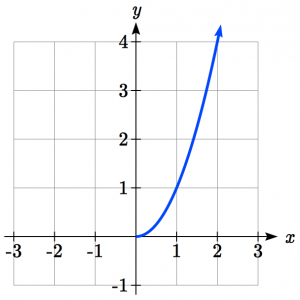
We can limit the domain to ![]() to restrict the graph to a portion that is one-to-one, and find an inverse on this limited domain.
to restrict the graph to a portion that is one-to-one, and find an inverse on this limited domain.
You may have already guessed that since we undo a square with a square root, the inverse of ![]() on this domain is
on this domain is ![]() .
.
You can also solve for the inverse function algebraically. If ![]() , we can introduce the variable
, we can introduce the variable ![]() to represent the output values, allowing us to write
to represent the output values, allowing us to write ![]() . To find the inverse we solve for the input variable.
. To find the inverse we solve for the input variable.
To solve for x we take the square root of each side. ![]() and get
and get ![]() , so
, so ![]() . We have restricted x to being non-negative, so we’ll use the positive square root,
. We have restricted x to being non-negative, so we’ll use the positive square root, ![]() or
or ![]() .
.
In cases like the example above where the variables are not descriptive, it is common to see the inverse function rewritten with the variable x: ![]() . Rewriting the inverse using the variable x is often required for graphing inverse functions using calculators or computers.
. Rewriting the inverse using the variable x is often required for graphing inverse functions using calculators or computers.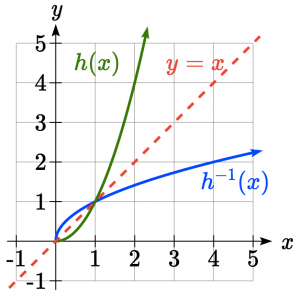
Note that the domain and range of the square root function do correspond with the range and domain of the quadratic function on the limited domain. In fact, if we graph ![]() on the restricted domain and
on the restricted domain and ![]() on the same axes, we can notice symmetry: the graph of
on the same axes, we can notice symmetry: the graph of ![]() is the graph of
is the graph of ![]() reflected over the line
reflected over the line ![]() . This is the case with all functions and their inverses.
. This is the case with all functions and their inverses.
Example of a Function and its Inverse Graphed
Given the graph of ![]() shown, sketch a graph of
shown, sketch a graph of ![]() .
.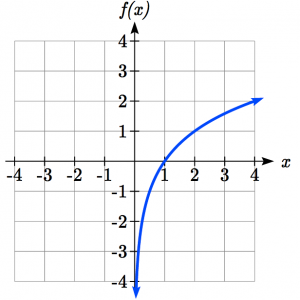
This is a one-to-one function, so we will be able to sketch an inverse. Note that the graph shown has an apparent domain of ![]() and range of
and range of ![]() , so the inverse will have a domain of
, so the inverse will have a domain of ![]() and range of
and range of ![]()
Reflecting this graph of the line ![]() , the point (1, 0) reflects to (0, 1), and the point (4, 2) reflects to (2, 4). Sketching the inverse on the same axes as the original graph:
, the point (1, 0) reflects to (0, 1), and the point (4, 2) reflects to (2, 4). Sketching the inverse on the same axes as the original graph: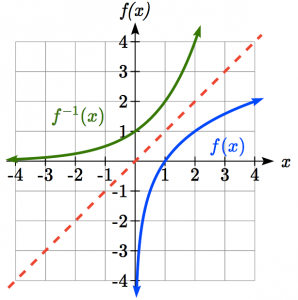
Finding Inverse Functions
We’ve already discussed that inverse functions undo the original function. However, consider when you have a function and you want to know its inverse. You will have to undo everything. When you are working with a computer program and use the undo button, the computer undoes the last thing you did, if you click it again, it undoes the thing before that, and so on. The same can be done with an inverse function. We simply look at all the steps a function takes and undo each step in reverse order. Just remember all of your order of operations rules.
Examples Finding Inverses Using Undo
a. Given ![]() , find
, find ![]()
What does the function actually do in this case? It takes a value, ![]() and:
and:
- Multiplies 3
- Subtracts 5
So the undo button should start by taking a value, we can call it ![]() also, at the last thing done and:
also, at the last thing done and:
- Add 5
- Divide 3
So our inverse ![]()
b. Given ![]() , find
, find ![]()
So we will start by consider what ![]() does, it takes a value
does, it takes a value ![]() :
:
- Cubes it
- Multiplies 8
- Adds 11
So the inverse, ![]() will undo these in the opposite order, take the value
will undo these in the opposite order, take the value ![]() and:
and:
- Subtract 11
- Divide 8
- Take the cube root
So we have ![]()
Another way to find inverses is algebraically solving for the other variable. This is best seen in applications.
Example of Finding Inverses in Applications
A beverage company has decided a new fun marketing tool would be to put their product in spherical containers. They know the volumes of the products they want, but they need to know the radii of the spheres to give the specifications to the container manufacturers. They need a way to use the formula for the volume of a sphere, ![]() to enter as a formula into their software to give the radius for any volume they decide they want.
to enter as a formula into their software to give the radius for any volume they decide they want.
We can approach this using an algebraic approach and solve ![]() for r instead of V:
for r instead of V:
![Rendered by QuickLaTeX.com \begin{array}{rcl} V&=&\dfrac{4}{3}\pi r^3\\ \dfrac{3}{4}V&=&\dfrac{3}{4}\dfrac{4}{3}\pi r^3\\ \dfrac{3}{4}V&=&\pi r^3\\ \dfrac{3}{4\pi}V&=&\dfrac{1}{\pi}\pi r^3\\ \dfrac{3}{4\pi}V&=&r^3\\ \sqrt[3]{\dfrac{3}{4\pi}V}&=&\sqrt[3]{r^3}\\ \sqrt[3]{\dfrac{3}{4\pi}V}&=&{r}\end{array}](https://ua.pressbooks.pub/app/uploads/quicklatex/quicklatex.com-11bfeb20787173d0a90d46280b362e92_l3.png)
so we have the inverse function: ![]()
Since the variables here are meaningful, we do not switch them, but we would introduce another function name, like ![]() and
and ![]() .
.
Try it Now 4
a. Given that ![]() find
find ![]()
b. Given that ![]() (With the restricted domain
(With the restricted domain ![]() ). Find
). Find ![]()
Try it Now Answers
-

- a.
 . In 60 minutes, 50 miles are traveled.
. In 60 minutes, 50 miles are traveled.
b. . To travel 60 miles, it will take 70 minutes.
. To travel 60 miles, it will take 70 minutes. - a.

b. (this is an approximation – answers may vary slightly)
(this is an approximation – answers may vary slightly) - a.

b.
Media Attributions
- Calgaryweather is licensed under a CC BY-NC (Attribution NonCommercial) license
- warningsign
- domainandrangeoffandinv
- 66example1
- 66example2
- 66example3
- 66example4
- 66example5

